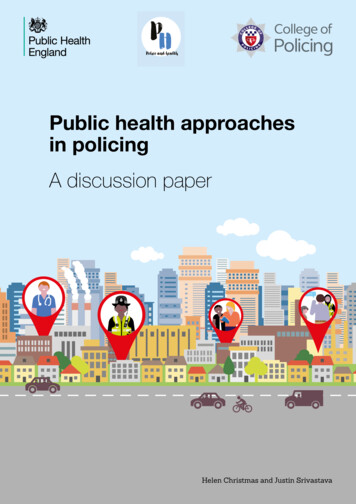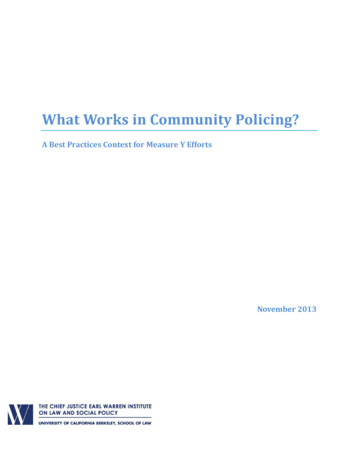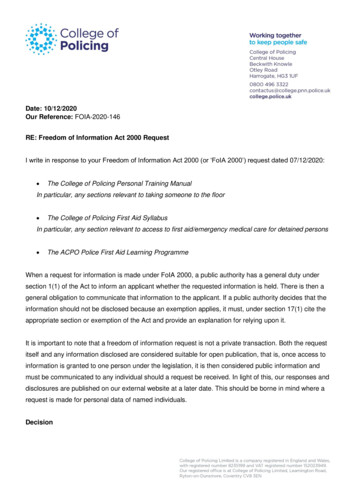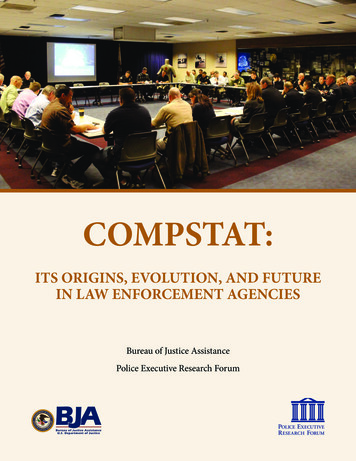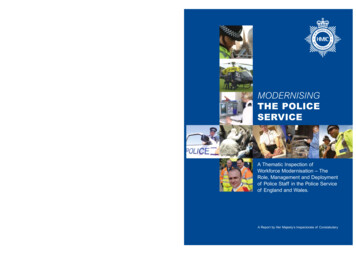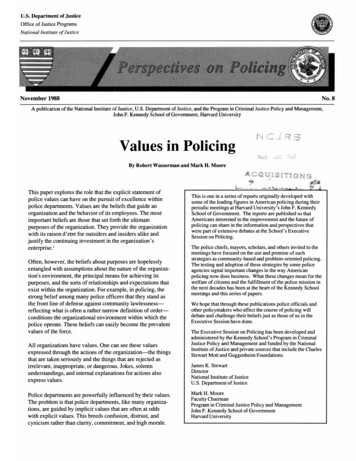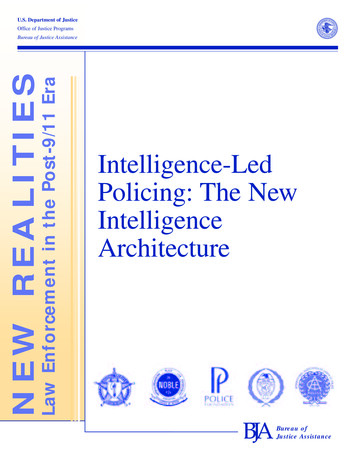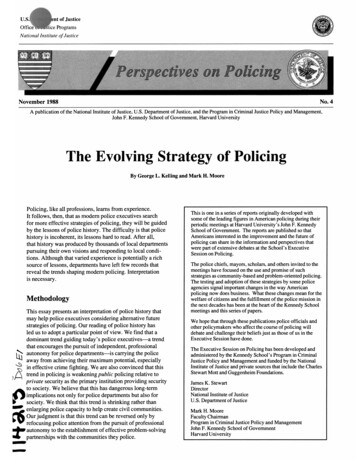
Transcription
U.S.nt of JusticeOffice u i .-:itlice ProgramsNational Institute of JusticeNovember 1988No. 4A publication of the National Institute of Justice,U.S. Department of Justice, and the Program in Criminal Justice Policy and Management,John F. Kennedy School of Government, Harvard UniversityThe Evolving Strategy of PolicingBy George L. Kelling and Mark H. MoorePolicing, like all professions, learns from experience.It follows, then, that as modem police executives searchfor more effective strategies of policing, they will be guidedby the lessons of police history. The difficulty is that policehistory is incoherent, its lessons hard to read. After all,that history was produced by thousands of local departmentspursuing their own visions and responding to local conditions. Although that varied experience is potentially a richsource of lessons, departments have left few records thatreveal the trends shaping modem policing. Interpretationis necessary.Methodology5!.2This essay presents an interpretation of police history thatmay help police executives considering alternative futurestrategies of policing. Our reading of police history hasled us to adopt a particular point of view. We find that adominant trend guiding today's police executives-a trendthat encourages the pursuit of independent, professionalautonomy for police departments-is carrying the policeaway from achieving their maximum potential, especiallyin effective crime fighting. We are also convinced that thistrend in policing is weakening public policing relative toprivate security as the primary institution providing securityto society. We believe that this has dangerous long-termimplications not only for police departments but also forsociety. We think that this trend is shrinking rather thanenlarging police capacity to help create civil communities.Our judgment is that this trend can be reversed only byrefocusing police attention from the pursuit of professionalautonomy to the establishment of effective problem-solvingpartnerships with the communities they police."f0This is one in a series of reports originally developed withsome of the leading figures in American policing during theirperiodic meetings at Harvard University's John F. KennedySchool of Government. The reports are published so thatAmericans interested in the improvement and the future ofpolicing can share in the information and perspectives thatwere part of extensivedebates at the School's ExecutiveSession on Policing.The police chiefs, mayors, scholars,and others invited to themeetings have focused on the use and promise of suchstrategies as community-based and problem-oriented policing.The testing and adoption of these strategies by some policeagencies signalimportant changes in the way Americanpolicing now does business. What these changes mean for thewelfare of citizens and the fulfillmentof the police mission inthe next decades has been at the heart of the Kennedy Schoolmeetings and this series of papers.We hope that through these publications police officials andother policymakers who affect the course of policing willdebate and challenge their beliefsjust as those of us in theExecutive Sessionhave done.The Executive Session on Policing has been developed andadministered by the Kennedy School's Program in CriminalJustice Policy and Management and funded by the NationalInstitute of Justice and private sources that includethe CharlesStewart Mott and GuggenheimFoundations.James K. StewartDirectorNational Institute of JusticeU.S. Department of JusticeMark H. MooreFaculty ChairmanProgram in Criminal Justice Policy and ManagementJohn F. Kennedy School of GovernmentHarvardUniversity
Delving into police history made it apparent that someassumptions that now operate as axioms in the field ofpolicing (for example that effectiveness in policing dependson distancing police departments from politics; or that thehighest priority of police departments is to deal with seriousstreet crime; or that the best way to deal with street crimeis through directed patrol, rapid response to calls for service,and skilled retrospective investigations) are not timelesstruths, but rather choices made by former police leadersand strategists. To be sure, the choices were often wiseand far-seeing as well as appropriate to their times. But thehistorical perspective shows them to be choices nonetheless,and therefore open to reconsideration in the light of laterprofessional experience and changing environmentalcircumstances.We are interpreting the results of our historical study througha framework based on the concept of "corporate strategy."'Using this framework, we can describe police organizationsin terms of seven interrelated categories:The sources from which the police construct thelegitimacy and continuing power to act on society.The definition of the police function or role insociety.The organizational design of police departments.The relationships the police create with the externalenvironment.The nature of police efforts to market or manage thedemand for their services.The principal activities, programs, and tactics onwhich police agencies rely to fulfill their missionor achieve operational success.The concrete measures the police use to defineoperational success or failure.Editor's note: This paper, among the many papersdiscussed at the Kennedy School's Executive Sessionon Policing, evoked some of the most spiritedexchanges among Session participants. The rangeand substance of those exchanges are captured ina companion Perspectives on Policing, "Debatingthe Evolution of American Policing."Using this analytic framework, we have found it usefulto divide the history of policing into three different eras.These eras are distinguished from one another by theapparent dominance of a particular strategy of policing.The political era, so named because of the close tiesbetween police and politics, dated from the introductionof police into municipalities during the 1840's, continuedthrough the Progressive period, and ended during the early1900's. The reform era developed in reaction to the political.It took hold during the 1930's, thrived during the 1950's and1960's, began to erode during the late 1970's. The reformera now seems to be giving way to an era emphasizingcommunity problem solving.66The reform era now seems to be givingway to an era emphasizing communityproblem solving. ))By dividing policing into these three eras dominated by aparticular strategy of policing, we do not mean to imply thatthere were clear boundaries between the eras. Nor do wemean that in those eras everyone policed in the same way.Obviously, the real history is far more complex than that.Nonetheless, we believe that there is a certain professionalethos that defines standards of competence, professionalism,and excellence in policing; that at any given time, one setof concepts is more powerful, more widely shared, and betterunderstood than others; and that this ethos changes overtime. Sometimes, this professional ethos has been explicitlyarticulated, and those who have articulated the conceptshave been recognized as the leaders of their profession.O.W. Wilson, for example, was a brilliant expositor of thecentral elements of the reform strategy of policing. Othertimes, the ethos is implicit-accepted by all as the tacitassumptions that define the business of policing and theproper form for a police department to take. Our task is tohelp the profession look to the future by representing itspast in these terms and trying to understand what the pastportends for the future.The political eraHistorians have described the characteristics of earlypolicing in the United States, especially the strugglesbetween various interest groups to govern the p l i c e . Elsewhere, the authors of this paper analyzed a portionof American police history in terms of its organizational trategy. The following discussion of elements of thepolice organizational strategy during the political eraexpands on that effort.ii4 %a8-
Legitimacy and authorizationEarly American police were authorized by local municipalities. Unlike their English counterparts, American policedepartments lacked the powerful, central authority of thecrown to establish a legitimate, unifying mandate for theirenterprise. Instead, American police derived both theirauthorization and resources from local political leaders,often ward politicians. They were, of course, guided by thelaw as to what tasks to undertake and what powers to utilize.But their link to neighborhoods and local politicians was sotight that both Jordan4and Fogelson5refer to the early policeas adjuncts to local political machines. The relationship wasoften reciprocal: political machines recruited and maintainedpolice in office and on the beat, while police helped wardpolitical leaders maintain their political offices by encouraging citizens to vote for certain candidates, discouragingthem from voting for others, and, at times, by assisting inrigging elections.The police functionPartly because of their close connection to politicians, policeduring the political era provided a wide array of services tocitizens. Inevitably police departments were involved incrime prevention and control and order maintenance, butthey also provided a wide variety of social services. In thelate 19th century, municipal police departments ran souplines; provided temporary lodging for newly arrived immigrant workers in station houses and assisted ward leadersin finding work for immigrants, both in police and otherforms of work.Organizational designAlthough ostensibly organized as a centralized, quasimilitary organization with a unified chain of command,police departments of the political era were neverthelessdecentralized. Cities were divided into precincts, andprecinct-level managers often, in concert with the wardleaders, ran precincts as small-scale departments-hiring,firing, managing, and assigning personnel as they deemedappropriate. In addition, decentralization combined withprimitive communications and transportation to give policeofficers substantial discretion in handling their individualbeats. At best, officer contact with central command wasmaintained through the call box.External relationshipsDuring the political era, police departments were intimatelyconnected to the social and political world of the ward.Police officers often were recruited from the same ethnicstock as the dominant political groups in the localities,and continued to live in the neighborhoods they patrolled.Precinct commanders consulted often with local politicalrepresentatives about police priorities and progress.Demand managementDemand for police services came primarily from twosources: ward politicians making demands on the organization and citizens making demands directly on beat officers.Decentralization and political authorization encouraged thefirst; foot patrol, lack of other means of transportation, andpoor communications produced the latter. Basically, thedemand for police services was received, interpreted, andresponded to at the precinct and street levels.Principal programs and technologiesThe primary tactic of police during the political era wasfoot patrol. Most police officers walked beats and dealtwith crime, disorder, and other problems as they arose, oras they were guided by citizens and precinct superiors.The technological tools available to police were limited.However, when call boxes became available, police administrators used them for supervisory and managerial purposes;and, when early automobiles became available, police usedthem to transport officers from one beat to a n t h e rThe. newtechnology thereby increased the range, but did not changethe mode, of patrol officers.Detective divisions existed but without their current prestige.Operating from a caseload of "persons" rather than offenses,detectives relied on their caseload to inform on othercriminal . The "third degree" was a common means ofinterviewing criminals to solve crimes. Detectives wereoften especially valuable to local politicians for gatheringinformation on individuals for political or personal, ratherthan offense-related, purposes.66 o spoliceto f f e r s walked beatsand dealt with crime, disorder, andother problems as they arose . .9 )Measured outcomesThe expected outcomes of police work included crime andriot control, maintenance of order, and relief from many ofthe other problems of an industrializing society (hunger andtemporary homelessness, for example). Consistent with their
political mandate, police emphasized maintaining citizen andpolitical satisfaction with police services as an importantgoal of police departments.In sum, the organizational strategy of the political era ofpolicing included the following elements:Authorization-primarily political.Function-crime control, order maintenance,broad social services.Organizational design-decentralized andgeographical.Relationship to environment-close and personal.Demand-managed through links between politiciansand precinct commanders, and face-to-face contactsbetween citizens and foot patrol officers.Tactics and ial order.patrol and rudimentaryand citizen satisfaction withThe political strategy of early American policing hadstrengths. First, police were integrated into neighborhoodsand enjoyed the support of citizens-at least the support ofthe dominant and political interests of an area. Second, andprobably as a result of the first, the strategy provided usefulservices to communities. There is evidence that it helpedcontain riots. Many citizens believed that police preventedcrimes or solved crimes when they occurred? And thepolice assisted immigrants in establishing themselves incommunities and finding jobs.66Officers were often required toenforce unpopular laws foisted onimmigrant ethnic neighborhoods bycrusading reformers . 9 ).The political strategy also had weaknesses. First, intimacywith community, closeness to political leaders, and adecentralized organizational structure, with its inabilityto provide supervision of officers, gave rise to policecorruption. Officers were often required to enforce unpopu-lar laws foisted on immigrant ethnic neighborhoods bycrusading reformers (primarily of English and Dutchbackground) who objected to ethnic values.1 Becauseof their intimacy with the community, the officers werevulnerable to being bribed in return for nonenforcementor lax enforcement of laws. Moreover, police closeness topoliticians created such forms of political corruption aspatronage and police interference in elections.ll Even thosefew departments that managed to avoid serious financial orpolitical corruption during the late 19th and early 20thcenturies, Boston for example, succumbed to large-scalecorruption during and after Prohibition.'*Second, close identification of police with neighborhoodsand neighborhood norms often resulted in discriminationagainst strangers and others who violated those norms,especially minority ethnic and racial groups. Often rulingtheir beats with the "ends of their nightsticks," policeregularly targeted outsiders and strangers for roustingand "curbstone ju tice."' Finally, the lack of organizational control over officersresulting from both decentralization and the politicalnature of many appointments to police positions causedinefficiencies and disorganization. The image of KeystoneCops-police as clumsy bunglers-was widespread andoften descriptive of realities in American policing.The reform eraControl over police by local politicians, conflict betweenurban reformers and local ward leaders over the enforcementof laws regulating the morality of urban migrants, and abuses(corruption, for example) that resulted from the intimacybetween police and political leaders and citizens produceda continuous struggle for control over police during thelate 19th and early 20th centuries.14Nineteenth-centuryattempts by civilians to reform police organizations byapplying external pressures largely failed; 20th-centuryattempts at reform, originating from both internal andexternal forces, shaped contemporary policing as we knewit through the 1970's.15Berkeley's police chief, August Vollmer, first rallied policeexecutives around the idea of reform during the 1920'sand early 1930's. Vollmer's vision of policing was thetrumpet call: police in the post-flapper generation wereto remind American citizens and institutions of the moralvision that had made America great and of their responsibilities to maintain that vision.I6It was Vollmer's protege,O.W. Wilson, however, who taking guidance fromJ. Edgar Hoover's shrewd transformation of the corruptand discredited Bureau of Investigation into the honest
and prestigious Federal Bureau of Investigation (FBI),became the principal administrative architect of the policereform organizational strategy.17Hoover wanted the FBI to represent a new force for lawand order, and saw that such an organization could capturea permanent constituency that wanted an agency to takea stand against lawlessness, immorality, and crime. Byraising eligibility standards and changing patterns of recruitment and training, Hoover gave the FBI agents stature asupstanding moral crusaders. By committing the organizationto attacks on crimes such as kidnapping, bank robbery,and espionage-crimes that attracted wide publicity andrequired technical sophistication, doggedness, and a nationaljurisdiction to solve-Hoover established the organization'sreputation for professional competence and power. Byestablishing tight central control over his agents, limitingtheir use of controversial investigation procedures (such asundercover operations), and keeping them out of narcoticsenforcement, Hoover was also able to maintain an unparalleled record of integrity. That, too, fitted the image of adogged, incorruptible crime-fighting organization. Finally,lest anyone fail to notice the important developments withinthe Bureau, Hoover developed impressive public relationsprograms that presented the FBI and its agents in the mostfavorable light. (For those of us who remember the 1940's,for example, one of the most popular radio phrases was,"The FBI in peace and war"-the introductory line in a radioprogram that portrayed a vigilant FBI protecting us fromforeign enemies as well as villains on the "10 Most Wanted"list, another HooverIFBI invention.)66 20th-century attempts at reform,originating from both internal andexternal forces, shaped. policing aswe knew it through the 1970's. 9.9.Struggling as they were with reputations for corruption,brutality, unfairness, and downright incompetence, municipal police reformers found Hoover's path a compelling one.Instructed by O.W. Wilson's texts on police administration,they began to shape an organizational strategy for urbanpolice analogous to the one pursued by the FBI.Legitimacy and authorizationReformers rejected politics as the basis of police legitimacy.In their view, politics and political involvement was theproblem in American policing. Police reformers thereforeallied themselves with Progressives. They moved to end theclose ties between local political leaders and police. In somestates, control over police was usurped by state government.Civil service eliminated patronage and ward influences inhiring and firing police officers. In some cities (Los Angelesand Cincinnati, for example), even the position of chief ofpolice became a civil service position to be attained throughexamination. In others (such as Milwaukee), chiefs weregiven lifetime tenure by a police commission, to be removedfrom office only for cause. In yet others (Boston, forexample), contracts for chiefs were staggered so as notto coincide with the mayor's tenure. Concern for separationof police from politics did not focus only on chiefs, however.In some cities, such as Philadelphia, it became illegal forpatrol officers to live in the beats they patrolled. The purposeof all these changes was to isolate police as completely aspossible from political influences.Law, especially criminal law, and police professionalismwere established as the principal bases of police legitimacy.When police were asked why they performed as they did,the most common answer was that they enforced the law.When they chose not to enforce the law-for instance,in a riot when police isolated an area rather than arrestedlooters-police justification for such action was found intheir claim to professional knowledge, skills, and valueswhich uniquely qualified them to make such tactical decisions. Even in riot situations, police rejected the idea thatpolitical leaders should make tactical decisions; that was apolice responsibility.18So persuasive was the argument of reformers to removepolitical influences from policing, that police departmentsbecame one of the most autonomous public organizations inurban g vernment.' Under such circumstances, policing acity became a legal and technical matter left to the discretionof professional police executives under the guidance of law.Political influence of any kind on a police department cameto be seen as not merely a failure of police leadership but ascorruption in policing.The police functionUsing the focus on criminal law as a basic source of policelegitimacy, police in the reform era moved to narrow theirfunctioning to crime control and criminal apprehension.Police agencies became law enforcement agencies. Theirgoal was to control crime. Their principal means was the useof criminal law to apprehend and deter offenders. Activitiesthat drew the police into solving other kinds of communityproblems and relied on other kinds of responses were
identified as "social work," and became the object ofderision. A common line in police circles during the 1950'sand 1960's was, "If only we didn't have to do social work,we could really do something about crime." Police retreatedfrom providing emergency medical services as wellambulance and emergency medical services were transferredto medical, private, or firefighting organization . The 1967President's Commission on Law Enforcement and Administration of Justice ratified this orientation: heretofore, policehad been conceptualized as an agency of urban government;the President's Commission reconceptualized them as partof the criminal justice system.Organizational designThe organization form adopted by police reformers generallyreflected the scientific or classical theory of administrationadvocated by Frederick W. Taylor during the early 20thcentury. At least two assumptions attended classical theory.First, workers are inherently uninterested in work and, ifleft to their own devices, are prone to avoid it. Second,since workers have little or no interest in the substance oftheir work, the sole common interest between workersand management is found in economic incentives forworkers. Thus, both workers and management benefiteconomically when management arranges work in waysthat increase workers' productivity and link productivity toeconomic rewards.Two central principles followed from these assumptions:division of labor and unity of control. The former positedthat if tasks can be broken into components, workers canbecome highly skilled in particular components and thusmore efficient in carrying out their tasks. The latter positedthat the workers' activities are best managed by apyramid ofcontrol, with all authority finally resting in one central office.6 6 . . . a generation of police officerswas raised with the idea that they merelyenforced the law . .))Using this classical theory, police leaders moved to routinizeand standardize police work, especially patrol work. Policework became a form of crimefighting in which policeenforced the law and arrested criminals if the opportunitypresented itself. Attempts were made to limit discretion inpatrol work: a generation of police officers was raised withthe idea that they merely enforced the law.If special problems arose, the typical response was to createspecial units (e.g., vice, juvenile, drugs, tactical) ratherthan to assign them to patrol. The creation of these specialunits, under central rather than precinct command, servedto further centralize command and control and weakenprecinct commander . Moreover, police organizations emphasized control overworkers through bureaucratic means of control: supervision,limited span of control, flow of instructions downward andinformation upward in the organization, establishment ofelaborate record-keeping systems requiring additional layersof middle managers, and coordination of activities betweenvarious production units (e.g., patrol and detectives), whichalso required additional middle managers.External relationshipsPolice leaders in the reform era redefined the nature ofa proper relationship between police officers and citizens.Heretofore, police had been intimately linked to citizens.During the era of reform policing, the new model demandedan impartial law enforcer who related to citizens in professionally neutral and distant terms. No better characterizationof this model can be found than television's Sergeant Friday,whose response, "Just the facts, ma'am," typified the idea:impersonal and oriented toward crime solving rather thanresponsive to the emotional crisis of a victim.The professional model also shaped the police view of therole of citizens in crime control. Police redefined the citizenrole during an era when there was heady confidence aboutthe ability of professionals to manage physical and socialproblems. Physicians would care for health problems,dentists for dental problems, teachers for educationalproblems, social workers for social adjustment problems,and police for crime problems. The proper role of citizensin crime control was to be relatively passive recipients ofprofessional crime control services. Citizens' actions ontheir own behalf to defend themselves or their communitiescame to be seen as inappropriate, smacking of vigilantism.Citizens met their responsibilities when a crime occurredby calling police, deferring to police actions, and being goodwitnesses if called upon to give evidence. The metaphor thatexpressed this orientation to the community was that of thepolice as the "thin blue line." It connotes the existence ofdangerous external threats to communities, portrays policeas standing between that danger and good citizens, andimplies both police heroism and loneliness.Demand managementLearning from Hoover, police reformers vigorously set outto sell their brand of urban policing.22They, too, performedon radio talk shows, consulted with media representatives
about how to present police, engaged in public relationscampaigns, and in other ways presented this image of policeas crime fighters. In a sense, they began with an organizational capacity-anticrime police tactics-and intensivelypromoted it. This approach was more like selling thanmarketing. Marketing refers to the process of carefullyidentifying consumer needs and then developing goodsand services that meet those needs. Selling refers to havinga stock of products or goods on hand irrespective of need andselling them. The reform strategy had as its starting point aset of police tactics (services) that police promulgated asmuch for the purpose of establishing internal control ofpolice officers and enhancing the status of urban police asfor responding to community needs or market demands.23The community "need" for rapid response to calls forservice, for instance, was largely the consequence ofpolice selling the service as efficacious in crime controlrather than a direct demand from citizens.66 o o twhen demanded bycitizens, was rejected as an outmoded,expensive f& 9.9Consistent with this attempt to sell particular tactics, policeworked to shape and control demand for police services.Foot patrol, when demanded by citizens, was rejected as anoutmoded, expensive frill. Social and emergency serviceswere terminated or given to other agencies. Receipt ofdemand for police services was centralized. No longer werecitizens encouraged to go to "their" neighborhood policeofficers or districts; all calls went to a central communications facility. When 91 1 systems were installed, policeaggressively sold 91 1 and rapid response to calls for serviceas effective police service. If citizens continued to usedistrict, or precinct, telephone numbers, some policedepartments disconnected those telephones or got newtelephone numbers.24Principal programs and technologiesThe principal programs and tactics of the reform strategywere preventive patrol by automobile and rapid response tocalls for service. Foot patrol, characterized as outmoded andinefficient, was abandoned as rapidly as police administrators could obtain cars.25The initial tactical reasons forputting police in cars had been to increase the size of theareas police officers could patrol and to take the advantageaway from criminals who began to use automobiles. Underreform policing, a new theory about how to make the besttactical use of automobiles appeared.O.W. Wilson developed the theory of preventive patrol byautomobile as an anticrime tactic.26He theorized that ifpolice drove conspicuously marked cars randomly throughcity streets and gave special attention to certain "hazards"(bars and schools, for example), a feeling of policeomnipresence would be developed. In turn, that sense ofomnipresence would both deter criminals and reassure goodcitizens. Moreover, it was hypothesized that vigilant patrolofficers moving rapidly through city streets would happenupon criminals in action and be able to apprehend them.As telephones and radios became ubiquitous, the availabilityof cruising police came to be seen as even more valuable:if citizens could be encouraged to call the police viatelephone as soon as problems developed, police couldrespond rapidly to calls and establish control over situations,identify wrong-doers, and
John F. Kennedy School of Government, Harvard University The Evolving Strategy of Policing By George L. Kelling and Mark H. Moore Policing, like all professions, learns from experience. It follows, then, that as modem police executives search for more effective strategies of policing, they will be guided by the lessons of police history.


